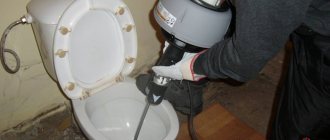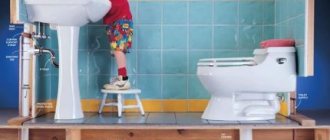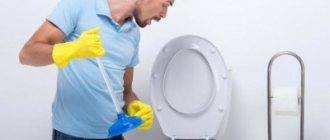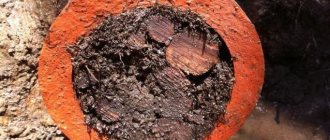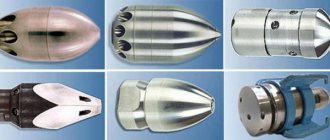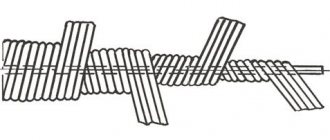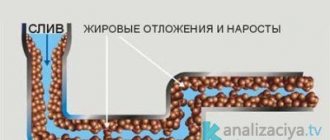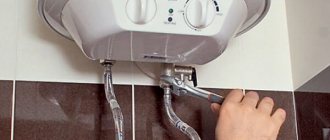Anyone can face the unexpected problem of a stagnant toilet. There is no point in putting off fixing plumbing problems. Let's look at the signs and causes of a clog in the toilet and learn how to remove a clog in the toilet with your own hands.
You can understand that the toilet is faulty by the following signs:
- dirty water does not leave the toilet completely after flushing;
- unpleasant odors appeared in the toilet;
- when flushing, the water fills the toilet bowl approximately halfway;
- The water goes down the drain very slowly.
If at least one of the listed signs is present in your toilet, we can confidently state that it is clogged and the drain needs to be cleaned.
Cleaning a clogged toilet using a plunger
Removing a blockage using a plunger is a mechanical method and is suitable for removing a blockage. If you suspect that a foreign object (child's toy, rag) has gotten into the toilet, it is better to remove it before you start working with the plunger.
You can remove objects by wearing rubber gloves. Otherwise, there is a risk of pushing debris further down the pipe and blocking the sewer system. A plunger is an effective remedy for clogged toilets.
- Before starting work, close all drains (bathtub, sinks).
- Place the plunger into the toilet drain hole. Pour five to six liters of water on top so that the rubber part of the plunger is completely covered.
- Pump the plunger at least ten times up and down. Movements should be sharp, but uniform. If the water goes away, then everything is done correctly.
Cleaning methods
I will look at methods for clearing clogs for each type of clog separately. The fact is that organic and inorganic substances, as well as blockages of different densities and with different fractions, require different approaches.
Paper
How to unclog a toilet if it is clogged with toilet paper or paper towels?
There is a relatively soft plug in it, and it is stuck in the narrowest place of the device - in the water seal. The cause of the blockage can simply be pushed towards the riser; at the same time, in 95% of cases it is destroyed and continues its path to the sewer well and beyond, without creating any new problems.
To push a paper plug into the riser, you need to create a water hammer - briefly increase the pressure on the side of the blockage closest to you. The easiest way to do this is with a plunger: cover the surface of the water with it and press down sharply. If necessary, repeat the operation several times. Beware of splashes: they fly in an unpredictable direction and do not ozonize the air.
There will be especially a lot of splashing if the plunger is smaller than the surface of the water in the toilet.
Is it possible to clear a clog without a plunger?
Its full functional analogue is a plastic bottle of soul-merrying drinks with a volume of 2 - 2.5 liters. All you have to do is cut off the bottom of the bottle and screw on the cap. The cleaning instructions are the same as when using a plunger: you need to press sharply on the bottle one or more times.
A bottle with the bottom cut off can replace a plunger.
Finally, at home you can use a simple cleaning method, which I often used when I was a plumber:
- a wet rag several times and place it on the surface of the water in the toilet;
- Press the rag firmly with the handle of a mop, brush, or any stick. From the first or second time, the resulting water hammer squeezes the cause of the blockage into the riser.
You might as well wrap a rag around a stick.
Fillers
What to do if the toilet is clogged with cat litter?
You can try to clear the blockage with sand using the same water hammer method. This works about half the time. The remaining sand is washed off by repeatedly draining the tank.
You need to understand that you are not clearing the blockage, but moving it to a horizontal section of the sewer - a bed in the basement of the house. Repeated blockage due to sand accumulation in horizontal pipes often leads to flooding of the basement or first floor.
If the drain is clogged, the basement will be flooded, and if the audits are closed, the first floor will be flooded.
Another way to clear a blockage with sand is to pierce it with a cable, allowing the water standing in the toilet to drain, and rinse the device with a large amount of water through a hose connected to the water supply.
With clumping clay litter and silica gel, the situation is much more bleak: you will have to arm yourself with long rubber gloves and remove the clumps of litter from the toilet by hand.
Once in the toilet, the clumping filler turns into a dense lump of clay.
Food waste
How to clear a clogged toilet caused by food waste?
Water hammer can help when it comes to crumbly porridge or finely chopped salad. Unfortunately, sometimes the faith of apartment building residents in the omnipotence of the sewer reaches the point of absurdity: I had to extract raw and boiled potatoes, pickled cucumbers and even large fish from it. These blockages can only be cleared by hand, using rubber gloves.
In some cases, with a small amount of food waste in the toilet, chemicals for clearing blockages (Mole, Tiret and others like them) help. As a rule, the product is a liquid with 5 to 15 percent sodium hypochlorite, sodium hydroxide NaOH, hydrochloric or oxalic acid; chemically aggressive substances dissolve organic matter upon prolonged contact.
In the photo, Tiret is a chemical for clearing blockages.
How to unclog a toilet with food waste yourself using this product?
- Scoop out all the water above the clog level and drain it into the sink or bathtub. The lower the concentration of the active substance (alkali or acid), the less effective chemical cleaning will be;
- Pour in a volume of at least half a liter;
- After a pause of 2 - 4 - 6 hours (depending on the volume of the blockage), rinse off the remains of the partially dissolved plug. If it doesn’t go away the first time, try using the water hammer method: there is a high chance that after dissolving some of the waste, the clog will succumb to your efforts.
Instead of specialized chemicals for clearing blockages, you can use any solutions of acids and alkalis: battery electrolyte, oxalic acid for cleaning ceramics, “Toilet Duckling” with its 15 percent hydrochloric acid in its composition, etc.
Study the composition of the product. The more alkali or acid it contains, the more effective it will be in clearing organic clogs.
Dry oxalic acid will clear the blockage and make the walls of the toilet snow-white.
Rags
How to remove a rag stuck in the toilet with your own hands?
This can only be done using a sewer cable.
The procedure is as follows:
- Unfold the cable and feed it into the toilet while your assistant continuously rotates the handle. The cable must be constantly tensioned, otherwise it will begin to fold into loops;
- Having caught the catch (this will be felt by the difficulty in rotating the handle), continue rotating in the same direction, slowly pulling the tool towards you. It is important not to let the rag fall off the hook.
Cleaning the toilet with a plumbing cable.
A special case
A rag is one of the few possible causes of a clogged sewer riser, which can become clogged between floors by getting caught on a flare burr at a sewer pipe connection. In this case, the algorithm for clearing the blockage is the same, but the cable is fed into the riser through an opened inspection above the blockage along the riser (they are located on the outer floors and every three floors of an apartment building).
You should not clear the clogged riser from the bottom up. At the time of cleaning, a column of sewage several meters high will hit the opened inspection. The spray has a very persistent aroma, is not afraid of profanity and overtakes you in any corner of the room.
Inspection for clearing blockages on a plastic sewer riser.
Construction garbage
It is extracted only and exclusively by hand, in seals. The small debris remaining in the toilet will be washed away after several flushes of the tank.
Construction mixtures
Gypsum that has hardened below the water level can sometimes be split by light blows of a hammer on a long chisel after scooping out the water. However, most often these attempts lead to the device splitting at the base, near the sole.
If any cement mortar has hardened in the toilet, it is basically impossible to eliminate the problem with little blood. The toilet is being replaced with a new one.
If the cement mortar has hardened in the toilet, its unscheduled replacement becomes inevitable.
Clearing a toilet blockage with a plastic bottle
You can quickly get rid of a clog in the toilet using improvised means. For example, using a regular plastic bottle with the bottom cut off and the cap tightly screwed on.
- The device must be carefully and slowly inserted into the drain.
- As soon as you feel the air pushing the bottle back, push it sharply to the very end of the drain hole. After this, remove the bottle from the drain with a sharp movement.
The water will go away and the congestion will be eliminated if the procedure is repeated two or three times.
Tools
As you know, he who is forewarned is forearmed. However, information about the causes of blockages is not the only weapon we will have to use. To effectively deal with blockages, you need a small set of tools.
What tool is useful to have at home in case of blockages?
- Plunger. There is not the slightest need to spend money on a professional tool with a piston and pressure gauge: a regular rubber cap on a plastic or wooden handle for home use is no worse. A reasonable price for a plunger is no more than 200 rubles;
Cheap and cheerful.
- Plumbing cable. Its simplest version is a piece of steel sling with a handle made of a steel tube bent in the shape of the letter “Z”. Factory-made products with a plastic shell rotating relative to the handle and a cable made from a spring wound around a steel core are no different from it in practical terms.
A good tool with a reasonable price.
Cables with a drum are convenient because they can be used alone, without an assistant. However, such a product costs several times more than a regular plumbing cable. As a rule, they are bought by professionals: the device can significantly save your time only when clearing a large number of blockages during the day.
The product in the photo is intended for professionals. With rare home use, such a tool will not pay for itself.
If your nearest hardware stores don’t have the tools I listed, it doesn’t matter. As you will see later, you can often make do with improvised items instead.
Clean the toilet with a solution of baking soda and vinegar
Vinegar and baking soda will help break through simple clogs in the toilet. You should not use this cleaning method if the corrugation (connection of the toilet bowl and pipe) is made of plastic. Hot water with baking soda and vinegar can ruin thin plastic.
Using vinegar and soda, you can quickly and effectively clean the toilet from contaminants such as grease plugs and food waste.
- Take half a packet of baking soda and pour it into the drain hole.
- Prepare one glass of vinegar and pour it into the toilet bowl.
- Wait half an hour and pour 3-5 liters of boiling water into the drain.
There are reasons for sadness
Comrades, let's start by separating the flies from the cutlets. The causes of blockage can be very, very different, and depending on the diagnosis, we have to choose treatment.
So, what can clog a toilet?
It's funny, but in my memory, using it for its intended purpose has never led to problems . Their cause is always a violation of sewerage operating standards. More specifically?
Please:
- Toilet paper and paper towels. Yes, they get wet in water, but at the same time the paper noticeably increases in volume. If the toilet below the water surface is completely clogged with pipifax, an attempt to flush will quite predictably lead to aggravation of the situation;
The most common cause of a clog is a thick wad of toilet paper.
An even more unpleasant scenario is when newspapers or, even worse, glossy sheets of magazines are used instead of toilet paper. They are much denser and tightly block the outlet of the plumbing fixture.
- Fillers for cat litter boxes. Of all the types of filler, only one can be flushed into the toilet - made from pressed sawdust, and then in small portions. To pour clumping filler, lumps of silica gel or sand into the sewer and hope for the best is unforgivable naivety: the blockage will be inevitable, like the collapse of capitalism;
- Food waste. Your white friend is capable of absorbing a couple of liters of sour borscht, but disposing of moldy pickled tomatoes or spoiled porridge into it is a guaranteed way to get clogged;
- Floor rags. They have an unpleasant habit of floating away into the fragrant distance when you pour out the water after washing the floors. The rag can clog the toilet outlet or, much worse, get caught on a burr lower down the riser: then drains from all the upper floors will begin to flow into your toilet and bathtub;
After washing the floors, floor rags love to go on a solo swim.
- Construction garbage. If you pour pieces of plaster and small fragments of concrete or brick into the sewer, the result will be quite predictable;
- Finally, it is completely beyond good and evil to dispose of unused construction mixtures by pouring them down the drain. Hardening of concrete or mortar in a plumbing fixture usually means the end of its career.
To find out what caused the clog, interview family members about their last actions before the problem occurred. If the culprit does not want to sign a confession, you will have to scoop out the water standing in the toilet to inspect and localize the problem.
How to break through a blockage with a cable
Using a special sewer cable will help you quickly and efficiently get rid of the blockage. It is better to do the work together.
Prepare unnecessary rags, oilcloth, a bucket or basin with water and dishwashing detergent.
- Roll out the oilcloth on the floor and cover the walls.
- Place the end of the cable into the drain hole and slowly move it down using a rotating motion.
- Once the cable has stopped and won’t go any further, move it back and forth.
- Remove the cable by lowering it onto the oilcloth. Clean with a cloth soaked in dishwashing liquid to remove unpleasant odors.
The toilet is clogged with cat litter, how to clean it
The invention of clumping and absorbent cat litter has made caring for pets much easier. Special mixtures that retain moisture and odors help keep paws dry and the apartment clean. However, the question inevitably arises about how to dispose of cat litter. Scooping out lumps with a scoop and then wrapping them in a bag and throwing them in the trash can is not always convenient. Many breeders strive to flush the granules down the toilet, often unaware of the unpleasant consequences this can have.
About mineral fillers
Mineral type filler is made from the following substances:
These substances have good adsorption properties and, in addition, perfectly absorb odor. Their advantages over others do not end there. These fillers are convenient because the “waste pebbles” clump together. That is, they can be easily and simply removed from the tray using a scoop.
The disadvantage of such cat litter products is the dust remaining on the animal’s paws and, of course, difficulty in disposal. This type of litter should not be flushed down the drain under any circumstances and should be thrown away. Flushing in small portions is possible, but it can also lead to blockage.
READ How to make toys for ferrets with your own hands
In what cases are sewer clogs likely?
In addition to the composition of the product used by animal owners for their toilet, the initial condition of the sewer pipes also plays an important role in the question of whether wood filler can be flushed down the toilet or some other kind.
For example, if the drains in an old house have not been changed for several decades, then the likelihood of a blockage increases significantly, even if you only flush wood products down the toilet and do this in small quantities.
There is also a high probability of clogging of sewer pipes when a large amount of waste filler is flushed at a time. The toilet is quite complex; there are specific bends in the drain. The design is made in this way in order to prevent the release of unpleasant odors and the rise of wastewater from the pipes.
Source
What to do if the toilet is clogged with cat litter
If this problem happens and your toilet is clogged with cat litter, you can try to break through the blockage with a plunger or a plastic bottle, especially if the blockage is located nearby and not much.
Please note that toilet plungers are different from sink plungers.
If it was not possible to clean it in this way, a plumbing cable will come to the rescue, which eliminates most problems with clogged sewer pipes. A very convenient thing, it rolls up into a coil and does not require much storage space.
What types of tray fillers are there?
It is no secret to any animal owner that you can fill the tray with fillers that are completely different in consistency and appearance. However, not everyone can answer the question of what exactly is the difference between these means. Meanwhile, how to clean cat litter with litter depends on the composition. Manufacturers of pet products today offer cat owners three types of fillers:
Each of them has both advantages and disadvantages. And, of course, they differ not only in composition and nuances of use, but also in methods of disposal.
What will happen if you flush prohibited fillers down the toilet?
Regardless of the type of filler, flushing a full tray down the toilet is prohibited. If the granules slip through the corrugation, there is a high probability that due to swelling they will settle in the pipes of the neighbors on the lower floors.
Prohibited fillers thrown down the toilet behave differently. Under the influence of water, they do not dissolve, but accumulate, simultaneously retaining other household waste. As a result, blockages form. Their location will not necessarily be in the cat owner’s apartment. The first floors are most often affected. Old structures where sewer pipes have not been replaced for a long time are in a high-risk area. Their interior, which has become rough over time, traps simple debris, not to mention such a serious test as a compressed lump of cat litter.
